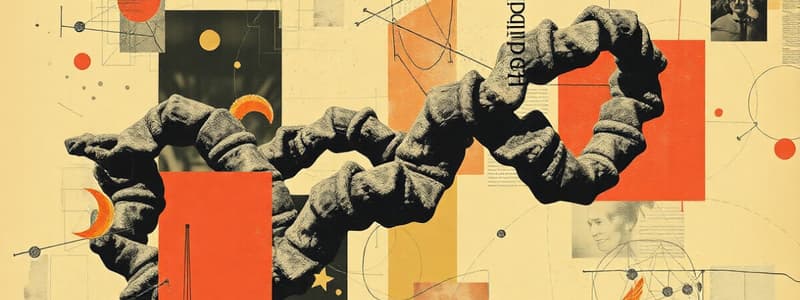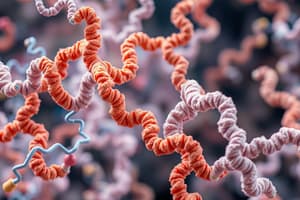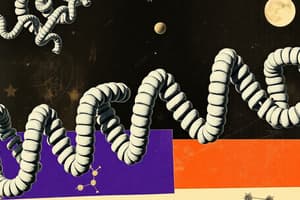Podcast
Questions and Answers
What is the main purpose of mRNA processing?
What is the main purpose of mRNA processing?
- To replicate DNA
- To facilitate the breakdown of mRNA
- To modify mRNA for translation (correct)
- To remove exons from the RNA sequence
Which nitrogenous base is found in RNA but not in DNA?
Which nitrogenous base is found in RNA but not in DNA?
- Adenine (A)
- Uracil (U) (correct)
- Cytosine (C)
- Thymine (T)
During transcription, what role does RNA polymerase play?
During transcription, what role does RNA polymerase play?
- It transports mRNA to the ribosome
- It unwinds the DNA segment (correct)
- It synthesizes proteins directly
- It bonds amino acids together
What happens to the RNA molecule after it is synthesized?
What happens to the RNA molecule after it is synthesized?
How does the structure of DNA differ from that of RNA?
How does the structure of DNA differ from that of RNA?
What is the significance of the Guanine Cap and Poly A tail in mRNA?
What is the significance of the Guanine Cap and Poly A tail in mRNA?
Which of the following is true about introns?
Which of the following is true about introns?
Where does mRNA processing occur in eukaryotic cells?
Where does mRNA processing occur in eukaryotic cells?
What function does the 5' cap serve in the primary mRNA transcript?
What function does the 5' cap serve in the primary mRNA transcript?
Which regions of DNA are transcribed but not translated?
Which regions of DNA are transcribed but not translated?
Which of the following is true about mature mRNA?
Which of the following is true about mature mRNA?
What is the role of codons in the process of translation?
What is the role of codons in the process of translation?
Which process is responsible for removing introns from the pre-mRNA?
Which process is responsible for removing introns from the pre-mRNA?
What is the significance of the universal nature of the DNA code?
What is the significance of the universal nature of the DNA code?
Where does the process of translation take place within the cell?
Where does the process of translation take place within the cell?
Which component is NOT included in the primary mRNA transcript?
Which component is NOT included in the primary mRNA transcript?
What is the primary function of tRNA in the process of translation?
What is the primary function of tRNA in the process of translation?
What feature of tRNA allows it to bind to the corresponding mRNA codon?
What feature of tRNA allows it to bind to the corresponding mRNA codon?
Which nucleotide sequence represents the anticodon for the mRNA codon UGG?
Which nucleotide sequence represents the anticodon for the mRNA codon UGG?
Which of the following statements about the start codon is true?
Which of the following statements about the start codon is true?
During translation, what happens to the tRNA molecule once it has delivered its amino acid?
During translation, what happens to the tRNA molecule once it has delivered its amino acid?
What is the initial step in the process of translation initiation?
What is the initial step in the process of translation initiation?
How does the ribosome move along the mRNA during translation?
How does the ribosome move along the mRNA during translation?
What is the role of the ribosomal RNA (rRNA) in the translation process?
What is the role of the ribosomal RNA (rRNA) in the translation process?
What symptom would likely arise from a deficiency in lactase?
What symptom would likely arise from a deficiency in lactase?
Which component of a nucleotide differs between DNA and RNA?
Which component of a nucleotide differs between DNA and RNA?
What is the primary function of hemoglobin in red blood cells?
What is the primary function of hemoglobin in red blood cells?
What characterizes the structure of DNA?
What characterizes the structure of DNA?
What condition results from a deficiency in clotting proteins?
What condition results from a deficiency in clotting proteins?
Which of the following nitrogenous bases is present only in RNA?
Which of the following nitrogenous bases is present only in RNA?
What is the role of acetaldehyde dehydrogenase in the body?
What is the role of acetaldehyde dehydrogenase in the body?
How are nucleotides linked within a single strand of DNA?
How are nucleotides linked within a single strand of DNA?
What is the primary cause of sickle-cell anemia?
What is the primary cause of sickle-cell anemia?
Which point mutation is most likely to result in a nonfunctional protein?
Which point mutation is most likely to result in a nonfunctional protein?
How do repair enzymes contribute to genetic stability?
How do repair enzymes contribute to genetic stability?
Which of the following statements about mutations is correct?
Which of the following statements about mutations is correct?
What accurately describes a nucleotide deletion?
What accurately describes a nucleotide deletion?
Which environmental factor is classified as a mutagen?
Which environmental factor is classified as a mutagen?
Which type of mutation is least likely to change the amino acid sequence?
Which type of mutation is least likely to change the amino acid sequence?
What is a common outcome of a frameshift mutation?
What is a common outcome of a frameshift mutation?
What forms the sides of the DNA ladder structure?
What forms the sides of the DNA ladder structure?
What is the significance of complementary base pairing in DNA?
What is the significance of complementary base pairing in DNA?
During DNA replication, which enzyme is responsible for adding new nucleotides?
During DNA replication, which enzyme is responsible for adding new nucleotides?
Which of the following describes the structure of the DNA double helix?
Which of the following describes the structure of the DNA double helix?
What are histones in relation to DNA?
What are histones in relation to DNA?
What is the result of DNA replication?
What is the result of DNA replication?
Why is DNA replication described as occurring in many places simultaneously?
Why is DNA replication described as occurring in many places simultaneously?
What is the approximate number of chromosomes in a human body cell?
What is the approximate number of chromosomes in a human body cell?
Flashcards
mRNA processing
mRNA processing
Modifying mRNA to form the final transcript, involving removal of introns and adding a 5' cap and poly-A tail.
Protein folding
Protein folding
Process where a polypeptide chain folds into a specific 3D shape, determining its function and ultimately creating traits.
Transcription
Transcription
Process that copies a DNA gene into a mRNA molecule, using RNA polymerase.
RNA polymerase
RNA polymerase
Signup and view all the flashcards
Introns
Introns
Signup and view all the flashcards
mRNA splicing
mRNA splicing
Signup and view all the flashcards
Guanine cap
Guanine cap
Signup and view all the flashcards
Poly-A tail
Poly-A tail
Signup and view all the flashcards
5' Capping
5' Capping
Signup and view all the flashcards
Splicing
Splicing
Signup and view all the flashcards
Primary mRNA Transcript
Primary mRNA Transcript
Signup and view all the flashcards
Mature mRNA Transcript
Mature mRNA Transcript
Signup and view all the flashcards
Codon
Codon
Signup and view all the flashcards
Translation
Translation
Signup and view all the flashcards
Ribosome
Ribosome
Signup and view all the flashcards
DNA double helix
DNA double helix
Signup and view all the flashcards
Complementary base pairing
Complementary base pairing
Signup and view all the flashcards
Human chromosome number
Human chromosome number
Signup and view all the flashcards
DNA Replication
DNA Replication
Signup and view all the flashcards
DNA Helicase
DNA Helicase
Signup and view all the flashcards
Chromatin
Chromatin
Signup and view all the flashcards
Histones
Histones
Signup and view all the flashcards
tRNA
tRNA
Signup and view all the flashcards
Anticodon
Anticodon
Signup and view all the flashcards
Start Codon
Start Codon
Signup and view all the flashcards
Ribosome Binding Region (RBR)
Ribosome Binding Region (RBR)
Signup and view all the flashcards
P Site
P Site
Signup and view all the flashcards
A Site
A Site
Signup and view all the flashcards
Stop Codon
Stop Codon
Signup and view all the flashcards
Mutation
Mutation
Signup and view all the flashcards
Point Mutation
Point Mutation
Signup and view all the flashcards
Frameshift Mutation
Frameshift Mutation
Signup and view all the flashcards
Nucleotide Substitution
Nucleotide Substitution
Signup and view all the flashcards
Nucleotide Deletion
Nucleotide Deletion
Signup and view all the flashcards
Why are DNA repair mechanisms important?
Why are DNA repair mechanisms important?
Signup and view all the flashcards
Nucleotide Insertion
Nucleotide Insertion
Signup and view all the flashcards
Why are most mutations harmful?
Why are most mutations harmful?
Signup and view all the flashcards
What are the monomers of nucleic acids?
What are the monomers of nucleic acids?
Signup and view all the flashcards
What are the two types of nucleic acids?
What are the two types of nucleic acids?
Signup and view all the flashcards
What is the difference between ribose and deoxyribose?
What is the difference between ribose and deoxyribose?
Signup and view all the flashcards
What are the four nitrogenous bases in DNA?
What are the four nitrogenous bases in DNA?
Signup and view all the flashcards
What are the four nitrogenous bases in RNA?
What are the four nitrogenous bases in RNA?
Signup and view all the flashcards
What does 'antiparallel' mean in DNA structure?
What does 'antiparallel' mean in DNA structure?
Signup and view all the flashcards
What holds the two DNA strands together?
What holds the two DNA strands together?
Signup and view all the flashcards
What is the function of DNA?
What is the function of DNA?
Signup and view all the flashcards
Study Notes
Gene Expression and Proteins
- Proteins are formed from different arrangements of 20 amino acids, like words from letters.
- Humans can make some amino acids but need others (essential amino acids) from food.
- Proteins differ based on the number of amino acids (length), order of amino acids, and type of amino acids.
- Amino acids are grouped by chemical properties, like hydrophobic (nonpolar), polar, and charged.
- Hydrophobic amino acids tend to be nonpolar; they frequently interact with each other.
- Polar amino acids have groups that attract water; they often participate in hydrogen bonding and other interactions.
- Charged amino acids have charged groups that interact with other charged groups.
- Cysteine amino acids are capable of forming disulfide bridges with other cysteine amino acids.
Protein Structure
- Primary structure: Linear sequence of amino acids, held together by peptide bonds.
- Secondary structure: Local folds (alpha helices, beta sheets) formed by hydrogen bonds.
- Tertiary structure: 3-D shape resulting from R-group interactions, including hydrophobic interactions, hydrogen bonds, ionic bonding, and disulfide bonds (ex. final or functional protein)
- Quaternary structure: Multiple polypeptide chains combining to form a functional protein.
Sickle Cell Anemia
- A disease caused by a mutation in the hemoglobin protein. One change in an amino acid sequence causes a change in hemoglobin structure.
- In hemoglobin, the order leads to red blood cells having a sickle shape, preventing efficient oxygen transport.
Protein Denaturation
- Loss of secondary, tertiary, or quaternary structure due to factors like high temperatures, extreme pH, and high salt concentrations.
- These factors disrupt stabilizing interactions (e.g., hydrogen bonds, ionic bonds, and disulfide bridges).
Proteins Determine Traits
- All cells have genetic material in the form of DNA.
- Genes code for proteins that determine traits.
- Genes directly influence organism characteristics.
Nucleic Acids
- Two main types of nucleic acids: DNA and RNA.
- Nucleotides are the building blocks of nucleic acids.
- Each nucleotide has a sugar (ribose or deoxyribose), a nitrogenous base (A, T, C, G, or U), and a phosphate group.
- DNA is double-stranded in a double helix shape, and RNA is single-stranded with a different sugar and bases
- DNA and RNA have different sugars. DNA has deoxyribose, and RNA has ribose.
- DNA has thymine, and RNA has uracil.
- DNA is typically larger than RNA in a cell.
- DNA strands run antiparallel, meaning they are oriented in opposite directions.
DNA Replication
- The process of copying DNA prior to cell division to ensure each new cell gets a complete copy of the genetic material.
- DNA replication is semi-conservative, one strand from the parent DNA and a newly synthesized strand.
Gene Expression Protein Building: Transcription and Translation
- Transcription: DNA code copied into mRNA.
- Translation: mRNA code used to assemble amino acids into a protein.
- mRNA: Messenger RNA
- tRNA: Transfer RNA
- rRNA: Ribosomal RNA
- Ribosomes are the site of protein synthesis.
Mutations
- Changes in DNA sequence.
- Most, but not all mutations are harmful.
- Mutations can lead to altered proteins that may have impaired function.
- Some mutations can be beneficial or neutral.
- Mutations can be caused by errors in DNA replication, exposure to environmental mutagens.
- Deletions and additions can shift the reading frame, meaning the sequence of amino acids is altered from the point of the mutation forward. Substitution of a nucleotide can lead to different amino acids (e.g. sickle cell).
Point Mutations
- Changes in a single nucleotide.
- Substitution: Replace one nucleotide with another.
- Deletion: Removing a nucleotide.
- Insertion: Adding a nucleotide.
- Frameshift mutations (insertion or deletion) result in changes in the reading frame, affecting the entire amino acid sequence downstream from the mutation.
Studying That Suits You
Use AI to generate personalized quizzes and flashcards to suit your learning preferences.




